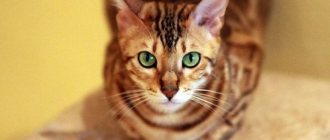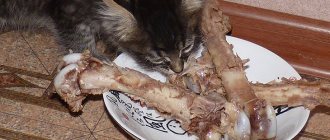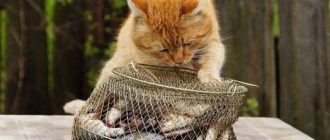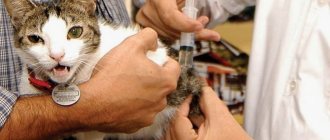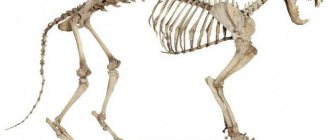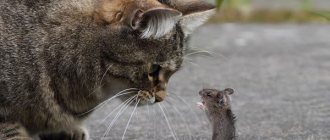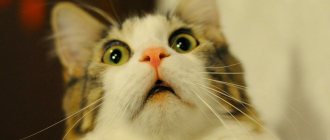Prevention of inguinal hernia in cats
The key reason for the appearance of such a pathology is poor development of the abdominal muscles and connective tissue. As a result, the body simply cannot keep the internal organs in their proper places. In addition, there are the following reasons for the appearance of a hernia in a cat on the stomach:
- trauma at birth;
- genetic predisposition;
- strong pressure from the inside on the abdominal muscles. Occurs as a result of regular constipation, diarrhea, and vomiting. In all of these processes, a strong contraction of the diaphragmatic region, stomach and abdomen is observed.
Hernias may appear after a cat is sterilized. The cause may be errors in caring for the animal, poor-quality surgery, the advanced age of the pet, or the effects of anesthesia.
Veterinarian examination
The main preventive measures include:
balanced diet
This will eliminate constipation and improve bowel function; When a kitten is born, it is important to cut the umbilical cord correctly; exclusion of injuries. It is worth monitoring the baby’s behavior and avoiding serious falls and bruises.
If you notice signs of a hernia, you should visit a veterinarian. An important condition for a quick recovery, in addition to prescribed treatment, is competent home care. Then the pet will quickly recover.
We invite you to familiarize yourself with: IV drip for a cat at home, rules for intravenous manipulation
Causes of umbilical hernia
In its structure, the pathology is a small opening (canal, gate), the part of the abdominal wall emerging from it forms a hernial sac. The movement of nearby organs occurs into it: the uterus or its parts, the bladder, the peritoneal omentum, and intestinal loops. Organs displaced from their anatomical places form hernial contents.
The umbilical type of the disease is most often observed in small kittens due to abnormalities in intrauterine development. In adult animals, hernias are acquired.
Veterinary experts believe that the following factors lead to the appearance of pathology in pets:
- Genetic predisposition is one of the main reasons for the formation of an umbilical hernia. The genes are responsible for the formation of the umbilical ring during fetal development. Malfunctions in the gene apparatus lead to an abnormal structure of the ligamentous apparatus and the umbilical vein, which provokes the formation of the umbilical opening.
- Some breeders believe that the cause of the pathology is the owner’s incorrect actions when the umbilical cord breaks, which leads to the expansion of the umbilical ring. The inexperience of a young mother cat that incorrectly gnaws the umbilical cord of newborns can also lead to trouble.
- Increased intra-abdominal pressure is a common cause of development. In both small kittens and adult animals, blood pressure increases with severe constipation, vomiting, and excessive physical activity.
- Various injuries and mechanical damage are the cause of acquired pathology. Falls from heights, blows, and bruises lead to stretching of the abdominal muscles and displacement of internal organs.
We recommend reading about what to do if your cat develops a tumor. You will learn about the reasons for opening a tumor, the rules for treating a wound, and treating a tumor. And here is more about the reasons why a cat doesn’t eat.
Everything you need to know about a cat's navel: does a cat have it or not?
It is human nature to make analogies. So why not compare the cat with yourself to discover another related anatomical feature.
Do cats have a belly button?
The question of whether cats have a navel is asked quite rarely, as a rule, out of love for their pet, wanting to know everything about it in detail, caring about its health.
Scientific “debunking” of misconceptions
The owner’s concern, which forces him to closely monitor the pet’s health and run to the veterinarian as soon as he notices a discrepancy with the generally accepted standard, is quite understandable. A small receding hairline on the abdomen is perfect for the role of such a discrepancy - as a result, a person grabs his head, suggesting various skin problems and a hernia.
Taking care of your health
The reason for the decision is the misconception about the absence of a belly button in pets. It's quite common. However, detailed examination leads to the discovery of noticeable features, and sometimes to non-existent problems. The bald patches on the cat's belly are only traces of the umbilical cord that once connected it to the mother's body.
Important! The kitten in the womb is connected by an umbilical cord, and this is the only way to receive oxygen and other important nutrition
Where is
A cat has a wet nose: why is it cold and what does it mean?
We must not forget that the difference in biological species means that the appearance of a cat's navel is noticeably different from a human's.
The location of the navel is determined by examining the hair growing on the abdomen. It is located where it grows sparser and shorter. The navel is a small white scar.
Of course, it is much easier to find it in a hairless or short-haired pet, but it occurs in any case.
Examination of the cat
How to find a cat's belly button
In a healthy cat, the remains of the umbilical cord, just like in a cat, almost completely disappear and should not stick out. This part of the body is noticeable only in newborn cats.
The kittens' navel is bright pink and sometimes convex. With age, the navel becomes pale and lighter. In adult cats, this point is covered with hair, making it difficult to detect.
Quick detection is possible if the animal has scanty fur or is completely bald.
You can try to lay a calm cat on its back and carefully examine its abdomen, namely the area near the ribs and pelvis. There is usually less fur at the point where the navel is located. The appearance may resemble a small scar. The cat's inguinal nipples can also serve as a reference point.
Physiological significance
Knowing your pet's physiology is no nonsense. Only through knowledge can you save your beloved animal from many health-related troubles - the same hernia, for example. We must not forget that self-diagnosis is not a solution at all, since the cat’s owner lacks qualifications, as a result, traces of the umbilical cord will seem like a catastrophic phenomenon.
When do kittens start eating on their own?
The remnants of biology taught at school will help answer the above question, whether cats have a navel. The navel in one form or another can be found in every animal belonging to the mammalian division. Cats are no exception to the rule, so the answer to the question of whether cats have an umbilical cord is identical.
Pregnancy takes a little over two months. During this entire period, the umbilical cord connecting the embryo to the uterus provides it with nutrients drawn from the mother’s body that affect the formation and development of the embryo.
Important! After some time, the mark from the umbilical cord disappears, becoming overgrown with fur and not differing in color from the other skin covering the tummy. This can make it difficult to spot where your cat's belly button is.
Why does this question arise?
Do cats have a navel? This question may surprise many. Why does it arise? There are two reasons for this :
- The most common reason is simple curiosity. Many owners love their pets so much that they want to know absolutely everything about them and their bodies. And human nature is such that we always compare something new with what we already know and look for analogies. Therefore, looking at your favorite pet, the question may arise: does the cat have a belly button? It’s so nice and interesting to sometimes find similarities with your favorite furry animal.
- Another reason also stems from the great love for the cat. Many owners are so worried about his health that they try to find all sorts of problems in order to prevent them in time. Such owners regularly examine the animal, and if they find something that, in their opinion, differs from the norm, they begin to become alarmed and look for ways to treat diseases. Therefore, after discovering a small bald spot on the stomach, attentive owners have assumptions about diseases - scabies, lichen, other skin diseases, hernia.
It may seem that the question of whether a cat has a belly button is idle curiosity. But in fact, it is important to know about the physiological characteristics of your beloved cat. This will help avoid many problems during his life. For example, you can quickly notice the presence of a disease such as an umbilical hernia. But you should not engage in self-diagnosis and search for non-existent problems. Small bald patches on the cat’s belly are traces of the umbilical cord that connected him to his mother’s body.
© shutterstock
How to find a cat's belly button
The main and initial mistake lies in the fact that the cat owner, looking for her navel, tries to find a depression or a scar - by analogy with her own navel. But in humans, the navel looks like a depression only because after the birth of the baby, the umbilical cord is cut and bandaged by obstetricians.
In cats, everything happens naturally, without surgical intervention. After the birth of the offspring, she independently gnaws the umbilical cord. And then he actively licks this place on each kitten. Cat saliva secretes vitamins B1, B6, B12 and contains lysozyme, a substance with antibacterial properties. In medicine, lysozyme has long been used as an antiseptic.
After this “medical” procedure, the remnants of the umbilical cord dry out quite quickly, and after a few days they disappear completely, leaving practically no traces on the kitten’s skin. Over time, the already barely noticeable mark fades even more. And later it becomes overgrown with fur.
In order to find a cat's navel, you need to turn the animal on its back and carefully examine its stomach. In the area between the chest and pelvis, in the upper third of this space, you can notice a slightly less hairy area of very small size. This is a cat's belly button.
Of all the representatives of the cat family, only the Sphynx has no particular difficulties in finding the navel - the hair of this breed is very short, less dense and the slightest changes in the skin are clearly visible. The mark from the umbilical cord is visible very clearly and looks like a tiny scar located in the indicated area.
The navel in cats is located in the lower abdomen. Finding it the first time is almost impossible due to the physiological characteristics of animals and fur.
Each kitten is connected to its mother by an umbilical cord, through which it receives oxygen and vital nutrients. Pregnancy in cats lasts a little over 2 months.
After this, the mother licks the wound on her baby's stomach, which promotes healing. Cat saliva contains several B vitamins, which have an antiseptic effect. After a few days, the remainder of the umbilical cord dries out and then falls off. At this point, the scar is not visible, since the mark does not differ in color and is overgrown with new hair.
In babies, an umbilical hernia often appears in the navel area. To the touch - soft and mobile, does not cause pain in the kitten. It can be detected after eating, as it becomes more convex. If a hernia is not detected at an early stage, the disease can lead to the death of the baby.
It will not be possible to find a cat’s navel right away, since it is not convex, like a person’s. Outwardly, it resembles a scar of small diameter. In babies it is slightly pinkish and stands out, but with age it lightens and becomes invisible. The fur makes finding the belly button even more difficult.
To find it you should:
- Place the cat on its back.
- Try to carefully examine his stomach.
- The navel is located between the lower nipples, and the scar is not covered with hair.
Photo of a cat's navel
Not many people know that cats have a navel, since it is usually not visually visible. Even with a thorough examination, it is impossible to notice it in most cases or can be confused with signs of a dermatological disease. In addition, there is a myth that these animals do not have a scar on their stomach from the umbilical cord. To dispel it, it is enough to understand the physiological characteristics of the pet.
What sparked the interest?
The question of whether cats have a belly button or not usually arises because for some owners, pets are like children.
In this regard, they constantly examine the animal’s body to identify various pathologies. If they notice something unusual, they may sound the alarm and go to the clinic.
In practice, these may turn out to be physiological features of the body structure. Knowing the characteristics of the cat’s body, you can avoid such incidents.
Information about the scar on the abdomen and its location in the animal can be useful for the owner, as this knowledge will help to notice an umbilical hernia or other pathologies in time.
Physiological characteristics of a cat
Each kitten is connected to its mother by an umbilical cord, through which it receives oxygen and vital nutrients. Pregnancy in cats lasts a little over 2 months.
After this, the mother licks the wound on her baby's stomach, which promotes healing. Cat saliva contains several B vitamins, which have an antiseptic effect. After a few days, the remainder of the umbilical cord dries out and then falls off. At this point, the scar is not visible, since the mark does not differ in color and is overgrown with new hair.
Sometimes the wound does not heal due to inflammation and the appearance of pus. This is due to the fact that an infection has entered this area. The process can be triggered by human intervention during birth or improper care of kittens after birth.
In babies, an umbilical hernia often appears in the navel area. To the touch - soft and mobile, does not cause pain in the kitten. It can be detected after eating, as it becomes more convex. If a hernia is not detected at an early stage, the disease can lead to the death of the baby.
Mr. Cat recommends: detection method
It will not be possible to find a cat’s navel right away, since it is not convex, like a person’s. Outwardly, it resembles a scar of small diameter. In babies it is slightly pinkish and stands out, but with age it lightens and becomes invisible. The fur makes finding the belly button even more difficult.
To find it you should:
- Place the cat on its back.
- Try to carefully examine his stomach.
- The navel is located between the lower nipples, and the scar is not covered with hair.
Treatment and diagnosis
On the cat owners forum you can find many stories about umbilical hernia in pets. Veterinarians and experienced felinologists strongly recommend consulting with a surgeon and not self-medicating.
The doctor makes an individual decision for each specific case:
- Prescribes, if necessary, examination of the convexity: x-ray or ultrasound;
- Applies conservative treatment: sets prolapsed organs and fixes the navel area with a bandage. Within one to two months, the purr will need a consultation and examination by a veterinarian.
Performs an operation: removes the hernial sac and stitches the umbilical opening. The animal is put on a blanket or a protective collar for two weeks so that the baby does not lick or break the postoperative suture.
You should know:
Surgical intervention is performed on a teenage kitten only when it is already possible to select the minimum dose of anesthesia.
How to recognize the symptoms?
A deviation from the norm that the pet owner should pay attention to is the prolonged healing of the navel after birth. Every person who has a cat should know what such a deviation looks like in order to take the pet to the veterinary clinic in time
An umbilical hernia in a newborn kitten can go undetected for a long time, causing treatment to be delayed. Owners should be alarmed if their pet’s umbilical cord has not fallen off 14 days after birth, as this may be the first symptom of the progression of the pathology. In a kitten, an umbilical hernia is accompanied by a lump in the abdominal area, which may not cause pain. As the hernial protrusion increases, pain syndrome subsequently appears. Additional symptoms are observed only if other internal organs are pinched. With an umbilical hernia, the following clinical picture in a kitten is likely:
Every person who has a cat should know what such a deviation looks like in order to take the pet to the veterinary clinic in time. An umbilical hernia in a newborn kitten can go undetected for a long time, causing treatment to be delayed. Owners should be alarmed if their pet’s umbilical cord has not fallen off 14 days after birth, as this may be the first symptom of the progression of the pathology. In a kitten, an umbilical hernia is accompanied by a lump in the abdominal area, which may not cause pain. As the hernial protrusion increases, pain syndrome subsequently appears. Additional symptoms are observed only if other internal organs are pinched. With an umbilical hernia, the following clinical picture in a kitten is likely:
- gagging;
- the wound in the navel area bleeds and does not heal well;
- loss of appetite;
- increased body temperature;
- digestive problems;
- broken stool;
- death of tissue around the navel.
Where is
Some people cannot find where a cat's belly button is. This is due to the fact that it has nothing in common with a person’s navel. Externally it is a small scar. In small kittens it may be pink and more noticeable, but over time it fades and becomes tiny. In addition, the body of animals is covered with hair, under the layer of which it is difficult to notice scars on the skin.
To find where a cat’s belly button is, follow these simple steps:
Place the animal on its back. Carefully examine the abdomen, paying attention to the lower part. The small, pale, hairless area will be the navel. In cats, it is located between the lower nipples. It is easier to find a scar on pets without hair.
Since hair does not grow on the mark of the umbilical cord, if it is accidentally discovered, the owners confuse the navel with lichen or other dermatological diseases
It is easier to find scars on pets without fur. Since hair does not grow on the mark of the umbilical cord, if it is accidentally discovered, the owners confuse the navel with lichen or other dermatological diseases.
Usually the scar does not cause any inconvenience to its owner and only serves as a reminder of the intrauterine connection with the maternal body. In rare cases, it may change its shape, size or color. If you notice changes, do not delay visiting your doctor, as they may be a sign of the development of an umbilical hernia or other disease.
The question is, of course, funny, but many people are interested in it. Either out of idle curiosity, or out of scientific and zoological interest. Well, if you have a question, we are simply obliged to provide the answer. So, do cats have a navel, where is it located and what does it look like? Let's talk about it.
A cat's navel - myth or reality?
From a purely scientific point of view, all animals that the mother bears within herself have a navel. It is logical that they should receive nutrients and oxygen during their intrauterine formation and development.
A mother cat bears kittens for about two months (65 days); after the birth of each kitten, she produces an afterbirth - the placenta. She herself bites the umbilical cord of each of her born babies.
From this it is logical to assume, even without deep scientific knowledge, that the umbilical cord was attached to the placenta on one side, and to the kitten on the other. This means that every cat, like every person, has a belly button, regardless of whether this cat is an Abyssinian or an ordinary “mongrel”!
Where to look for a cat's belly button?
Well, we have decided on the presence of a belly button, but now you will want to check it on your pet. Where exactly is a cat's belly button? Like ours, it is located on the stomach. There are no hairs in this place, although it may be covered by fur that grows around.
There is no need to grope and try to find the dimple, like in humans. Even though we are mammals, like cats, our belly buttons and other features are different. Belly buttons may vary slightly from cat to cat, but they look like a hairless, rounded area at the bottom of the belly, roughly between the two lower nipples.
In hairless or less furry cats, finding the belly button is even easier. And you definitely can’t confuse it with a nipple. We hope you successfully found your pet’s treasured navel and now you know for sure that cats have it!
The navel in cats is located in the lower abdomen. Finding it the first time is almost impossible due to the physiological characteristics of animals and fur.
Each kitten is connected to its mother by an umbilical cord, through which it receives oxygen and vital nutrients. Pregnancy in cats lasts a little over 2 months.
After this, the mother licks the wound on her baby's stomach, which promotes healing. Cat saliva contains several B vitamins, which have an antiseptic effect. After a few days, the remainder of the umbilical cord dries out and then falls off. At this point, the scar is not visible, since the mark does not differ in color and is overgrown with new hair.
In babies, an umbilical hernia often appears in the navel area. To the touch - soft and mobile, does not cause pain in the kitten. It can be detected after eating, as it becomes more convex. If a hernia is not detected at an early stage, the disease can lead to the death of the baby.
It will not be possible to find a cat’s navel right away, since it is not convex, like a person’s. Outwardly, it resembles a scar of small diameter. In babies it is slightly pinkish and stands out, but with age it lightens and becomes invisible. The fur makes finding the belly button even more difficult.
To find it you should:
- Place the cat on its back.
- Try to carefully examine his stomach.
- The navel is located between the lower nipples, and the scar is not covered with hair.
Physiological significance
It is reasonable to assume that all animals that are carried by a mother inside her body have a navel. After all, it is through the umbilical cord that the developing fetus receives through the placenta from the mother’s body all the necessary nutrients that are needed to support nascent life, build a new organism, its successful formation and development, and saturate the cells of the small lump with oxygen. This, accordingly, applies to cats.
A cat carries her kittens for about two months (sixty-five days to be exact). All this time, through the umbilical cord, the fetus receives everything it needs from the mother. During the birth process, after the birth of each kitten, their mother releases an afterbirth (this is the placenta). The cat independently bites the umbilical cord of all newborns. It is obvious that the umbilical cord, on the one hand attached to the placenta, on the other hand is attached directly to the kitten. This means that just like humans, cats have a navel, regardless of their breed.
Therefore, we can safely give a positive answer to the question of whether cats have a navel. How can you detect it in your cat?
How to find a cat's belly button
If the processes of gestation and birth of humans and cats are so similar, then why don’t they have a navel in the form we are used to seeing on our bodies? The answer is quite simple.
A person's navel looks the way we are used to seeing it for one simple reason. After the baby is born, the umbilical cord is cut and tied by an obstetrician. Cats chew it through and then lick it so that the tear site heals. Their saliva contains several B vitamins and the healing process is fast.
A few days after birth, the remnants of the umbilical cord completely fall off, and the mark on the kitten’s tummy heals and almost completely disappears. At first you can easily notice it - it will be bright pink. Over time, it fades and becomes light. In addition, this area is covered with fur and the navel is quite difficult to notice. A cat's belly button looks different than a human's, but he still has one.
To find where your cat's belly button is, you need to lay her on her back and examine her stomach. You should look for it in the area between the ribs and the beginning of the pelvis. The location of the navel may vary slightly among kittens. It can usually be found between the lower pair of nipples.
You can determine the approximate location of the navel by examining the fur on the tummy. Where it is least, that is where you should look. It looks like a small white scar.
Of course, if the cat is fluffy, finding the navel can be quite problematic. It is most easily detected in hairless or short-haired cats. But, regardless of the breed, you can be sure that cats have a belly button.
The navel in cats is located in the lower abdomen. Finding it the first time is almost impossible due to the physiological characteristics of animals and fur.
Each kitten is connected to its mother by an umbilical cord, through which it receives oxygen and vital nutrients. Pregnancy in cats lasts a little over 2 months.
After this, the mother licks the wound on her baby's stomach, which promotes healing. Cat saliva contains several B vitamins, which have an antiseptic effect. After a few days, the remainder of the umbilical cord dries out and then falls off. At this point, the scar is not visible, since the mark does not differ in color and is overgrown with new hair.
In babies, an umbilical hernia often appears in the navel area. To the touch - soft and mobile, does not cause pain in the kitten. It can be detected after eating, as it becomes more convex. If a hernia is not detected at an early stage, the disease can lead to the death of the baby.
It will not be possible to find a cat’s navel right away, since it is not convex, like a person’s. Outwardly, it resembles a scar of small diameter. In babies it is slightly pinkish and stands out, but with age it lightens and becomes invisible. The fur makes finding the belly button even more difficult.
To find it you should:
- Place the cat on its back.
- Try to carefully examine his stomach.
- The navel is located between the lower nipples, and the scar is not covered with hair.
Does a cat have a belly button: where to look, does it exist at all?
In the article I will talk about cats’ navels and whether they have one. Let me consider its physiological significance. I’ll tell you where to look for this organ in a cat.
Cats are the most common pets. They have long won the world's love. But not all owners know some of the physiological characteristics of their furry friends. One of them is the cat's belly button. Where is it located and what function does it perform?
Does a cat have a belly button?
Often, the question of whether a cat has a belly button arises out of idle curiosity. It is important to know that all mammals have a navel, so representatives of the cat family also have one. It is not as pronounced as in humans, but you can still find it.
Features of physiology
All cats have a belly button, just like other mammals. The presence of a special scar on the abdomen is due to the fact that during pregnancy, kittens feed from the mother’s body. All nutrients and oxygen enter their body through the umbilical cord. She connects each kitten with its mother.
After the birth of the offspring and the delivery of the placenta, the cat independently gnaws the umbilical cord. Afterwards she licks her wounds. Since the animal’s saliva contains substances that have antiseptic properties, they heal quickly. After the remnants of the umbilical cord fall off, the scar becomes almost invisible, so it may not be visible during examination.
Only in rare cases does a kitten's navel remain large for a long time. Redness or purulent discharge may be observed. The reason for such phenomena is infection in an open wound. Even human intervention in the process of childbirth or improper care of babies after their birth can trigger the inflammatory process.
Do cats have a belly button?
Remembering what the navel is, it is easy to guess about its presence in all placental mammals, including the cat family. The navel is the site where the umbilical cord attaches to the embryo during fetal development. In turn, the umbilical cord serves as a channel of communication between the organisms of the mother and child, ensuring gas exchange and the supply of nutrients to the fetus. After the baby is born, the umbilical cord dries out, leaving a small scar on the newborn’s body that lasts for life. Therefore, any cat has such a mark, regardless of breed. This fact is confirmed by veterinarians.
Why do misunderstandings arise?
Often caring, but overly emotional cat owners mistake the cat's navel for symptoms of some disease, for example, lichen or scabies. Unnecessary visits to the veterinarian become a serious stress for both the animal and its owner. Therefore, it is important to know whether cats have a belly button, to be able to find it on your pet’s body, and not to confuse it with really serious manifestations.
Be attentive to your pets, take care of them properly, and then their sincere, selfless gratitude will not take long to arrive. The more attention given to pets, the happier they become and the more joy they bring to their owners. Don't be afraid to be curious and learn more about your pets!
Where is
Some people cannot find where a cat's belly button is. This is due to the fact that it has nothing in common with a person’s navel. Externally it is a small scar. In small kittens it may be pink and more noticeable, but over time it fades and becomes tiny. In addition, the body of animals is covered with hair, under the layer of which it is difficult to notice scars on the skin.
To find where a cat’s belly button is, follow these simple steps:
Place the animal on its back. Carefully examine the abdomen, paying attention to the lower part. The small, pale, hairless area will be the navel. In cats, it is located between the lower nipples. It is easier to find a scar on pets without hair.
Since hair does not grow on the mark of the umbilical cord, if it is accidentally discovered, the owners confuse the navel with lichen or other dermatological diseases
It is easier to find scars on pets without fur. Since hair does not grow on the mark of the umbilical cord, if it is accidentally discovered, the owners confuse the navel with lichen or other dermatological diseases.
Usually the scar does not cause any inconvenience to its owner and only serves as a reminder of the intrauterine connection with the maternal body. In rare cases, it may change its shape, size or color. If you notice changes, do not delay visiting your doctor, as they may be a sign of the development of an umbilical hernia or other disease.
To begin with, it should be recalled that the cat belongs to the class of mammals and the infraclass of placentals, that is, higher animals. A distinctive feature of all placentals is the birth of offspring at a relatively developed stage. This became possible when, during the course of evolution, the females of this species acquired an embryonic organ - the placenta.
It is through the placenta that nutrition of the fetus and its prenatal development are carried out. It transfers all nutrients and antibodies from mother to embryo. Each embryo is connected to the mother's body by an umbilical cord.
Consequently, every newborn creature of the mammalian class, and therefore every kitten, has an umbilical cord. And the kitten also has a belly button.
Where is the belly button in dogs and is there one at all?
Contents hide
At first glance, the question may seem stupid. But it has an important side property: the minute you brush it off, the thought of a dog’s belly button (or rather, its presence or absence) will literally begin to haunt you. Soon you will even be able to dive into the relevant research: humans have a belly button, and it is clearly visible, but where are dogs?
It’s the same with us: one day this thought treacherously crept into my head and didn’t want to come out. So we turned to expert advice from Dr. Margret Casal, a professor at the Center for Genetic Research at the University of Pennsylvania School of Veterinary Medicine.
So does a dog have a belly button? The short answer is, of course, yes. Just like cats, rabbits and, naturally, people have it.
It turns out that all mammals have a navel (umbilical cord), with the exception of marsupials (for example, kangaroos), as well as oviparous mammals (platypus).
What exactly is the navel? This is the remnant of the umbilical cord attachment point that was connected to the placenta before birth. Through this route, oxygen and nutrients enter the fetal body.
After the puppies are born, the mother dog chews (gnaws through) the umbilical cords a few inches from the body of her pups. The remaining appendage then falls off on its own within the first three days of the puppy's life. Surely, if you have ever observed newborn puppies, you have seen small sticks sticking straight out of their tummies - these are the remains of the umbilical cord. The scar left on the puppy’s body in this way heals quickly and successfully, leaving virtually no traces.
Why can't we see a dog's belly button? As Dr. Casal explains, the most common theory (and in fact there are several opinions on this matter) says that the human umbilical cord is tied, and not torn or chewed, as in our case. Therefore, our human navel always remains a kind of reminder of how we were born into this world. And the small scar that remains in dogs soon becomes overgrown with thick fur and ceases to be noticeable to prying eyes.
However, as Dr. Casal warns, if you do notice a prominent “belly button” on your puppy, then try to immediately have your pet checked by a veterinarian for the presence of a hernia. The specialist will conduct the appropriate research and determine how dangerous it is for your dog.
Original publication: Do Dogs Have Belly Buttons? Author: Kathy Blumenstok.
Signs for urgent medical attention
Possible umbilical complications occur especially often in newborn pets. Contacting a veterinarian is necessary when a depressed general condition is observed. The newborn may refuse to eat, and an increase in temperature may also be observed.
The infected navel is red and swollen. This place can become a point of entry for infection. The navel becomes inflamed when the mother chews the stump too short. The disease can also occur if the mother has dental disease.
An infected belly button often begins to fester. The umbilical stump is closely connected to the kitten's internal organs. For example, infection poses a real threat to the liver.
Important! Septicemia develops if left untreated and leads to the death of the individual. To prevent the death of valuable breeds, breeders treat the navel of a newborn with iodine
If necessary, treatment with disinfectants must be repeated
To prevent the death of valuable breeds, breeders treat the navel of a newborn with iodine. If necessary, treatment with disinfectants must be repeated.
If local treatment does not improve the condition, general treatment is used. For example, a doctor may prescribe antibacterial drugs that are administered intravenously or intramuscularly. Sometimes stimulant therapy is used. Modern veterinarians successfully use new homeopathic remedies.
Important! Veterinarians consider umbilical diseases to be infectious. Even at the first signs, the disease can be transmitted to all kittens born.
It is usually not necessary to see a doctor too urgently due to the discovery of a navel. Any movement from a familiar environment is stressful for the animal.
Care and attention are important for a pet, in this case he will respond with sincere gratitude. The owner's curiosity will help prevent the development of a serious illness
After all, the health of a pet is a truly important aspect for everyone’s well-being.
https://kotsobaka.com/koshki/pupok-u-kota.htmlhttps://usatiki.ru/est-li-u-koshek-pupok/https://gafki.ru/koshki/pupok-u-kota. html
Physiological characteristics of a cat
Each kitten is connected to its mother by an umbilical cord, through which it receives oxygen and vital nutrients. Pregnancy in cats lasts a little over 2 months.
After this, the mother licks the wound on her baby's stomach, which promotes healing. Cat saliva contains several B vitamins, which have an antiseptic effect. After a few days, the remainder of the umbilical cord dries out and then falls off. At this point, the scar is not visible, since the mark does not differ in color and is overgrown with new hair.
In babies, an umbilical hernia often appears in the navel area. To the touch - soft and mobile, does not cause pain in the kitten. It can be detected after eating, as it becomes more convex. If a hernia is not detected at an early stage, the disease can lead to the death of the baby.
